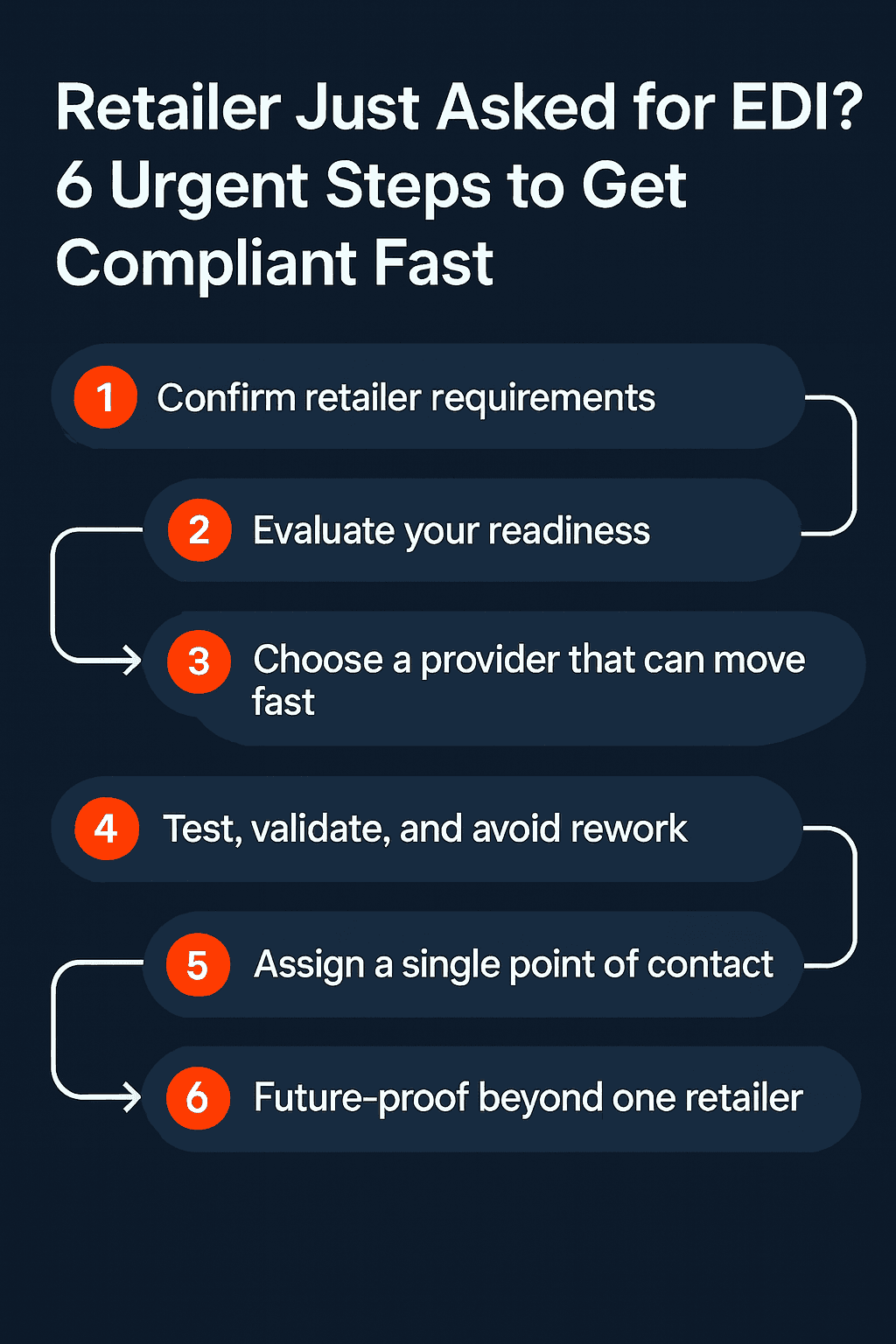Got your first retailer EDI request? Follow these 6 urgent steps to get compliant quickly, avoid costly mistakes, and meet partner requirements.
If a major retailer just asked for EDI and you don’t have a system in place, don’t panic — but do take action. Retailer EDI requirements can feel overwhelming, especially if this is your company’s first time dealing with electronic data interchange (EDI). But delays, mistakes, or missed deadlines can put relationships, revenue, and business growth at risk. Fortunately, meeting your EDI compliance goals quickly doesn’t have to derail your daily operations.
If you've just received your first EDI request from a retail partner, you're in luck. This guide will walk you through six practical steps to help you respond confidently, meet order fulfillment obligations swiftly, avoid costly missteps, and meet your trading partner’s EDI compliance mandates as fast as possible. Whether you’re selling to a national chain or shipping through a third-party logistics (3PL) service, the steps below will help you get EDI-ready and stay on track.
What Does It Mean to Be EDI Compliant?
Becoming EDI compliant means more than just sending a PDF invoice or uploading a spreadsheet. Retailers expect suppliers to follow precise rules for exchanging digital business documents. This includes specific formats, communication protocols, and acknowledgments — all within a tightly managed timeline.
At a minimum, most retailers require the ability to send and receive a basic EDI document set. This typically involves:
Purchase orders (850s) sent from the retailer to the supplier
Advance ship notices (856s) notifying the retailer of upcoming deliveries
Invoices (810s) to request payment for fulfilled orders
Functional acknowledgments (997s) to confirm receipt and acceptance of documents
Each of these documents must follow a standardized format. Retailers may also provide an implementation guide outlining their exact formatting rules and EDI data expectations. Even one missing required field or formatting detail can result in rejected transactions, payment delays, or costly chargebacks.
If this sounds technical, that’s because it is. But modern EDI platforms simplify this process by automating document creation, mapping, and validation, so your team doesn’t have to manage the formatting rules manually.
Get EDI Compliant Quickly: Your 6-Step Action Plan
When a retailer sets a deadline, you're expected to respond within the required timeframe. EDI onboarding is about more than just checking boxes. To protect your margins and relationships, you’ll need to make informed decisions throughout the entire process, avoiding delays and financial penalties associated with DIY setups, mismatched systems, or outdated tools.
Below is a skimmable breakdown of the six steps covered in this guide. Let’s take a closer look at each one and see how they fit into your compliance timeline.
Step | Why It Matters |
|---|---|
Confirm retailer requirements | Avoids rework, rejected documents, and delays |
Evaluate your readiness | Helps choose the right approach and provider |
Choose a provider that can move fast | Cuts onboarding from weeks to days |
Test, validate, and avoid rework | Prevents chargebacks and missed deadlines |
Assign a single point of contact | Keeps communication organized and on schedule |
Future-proof beyond one retailer | Ensures you can scale to multiple partners easily |
Step 1: Confirm What the Retailer Actually Requires
Not all retailers have the same EDI requirements. Some trading partners may only need you to send basic EDI invoices and purchase orders. Others may require additional EDI transactions, such as shipping notices or inventory updates.
Request the retailer’s EDI implementation guide, which will outline exactly which electronic documents they require, the format to use (such as ANSI X12), and the communication protocol they expect (such as SFTP). They may also specify testing requirements and timelines for onboarding.
Misunderstanding or guessing at these requirements can lead to rejected files, delayed order fulfillment, or strained trading partner relationships. Getting clarity from the start ensures you build the right connections and meet compliance standards from day one.
Step 2: Evaluate Your Readiness Honestly
Before committing to an EDI solution, take a clear-eyed look at your current resources. Do you have an internal IT team that can manage integrations and testing? Are you already using an ERP system that supports EDI connections, or are you starting from scratch?
Many small businesses make the mistake of thinking they can patch something together manually. But trying to meet retailer requirements through spreadsheets or email attachments often leads to missed deadlines and unnecessary chargebacks.
It's okay if you're not equipped to handle EDI setup in-house. Many small and midsize businesses aren’t. What matters is recognizing your limitations early so you can avoid wasted time and choose a partner that simplifies the entire process.
Step 3: Choose a Provider That Can Move Fast
Time matters when you're working against a retailer's required EDI deadline. Traditional legacy providers can take weeks or months to get you live. While they may offer deep customization, EDI integration often involves heavy IT involvement and ongoing maintenance.
Orderful’s web EDI solution is ideal for small and midsize suppliers to meet EDI mandates quickly. With preconfigured workflows and real-time document exchange, it eliminates guesswork, allowing you to focus on fulfilling orders.
Step 4: Test, Validate, and Avoid Rework
Testing is a critical part of the process. Before going live, your system needs to send and receive EDI documents in the format your retailer expects, with no missing fields, incorrect codes, or mismatched data. One formatting error can set an entire order back.
Look for a platform that includes built-in validation and testing environments. These tools help you catch problems early and confirm that your documents meet compliance standards.
Validation is also where many businesses run into avoidable friction. If your EDI system doesn’t automatically flag formatting issues, you’ll likely find out through a rejected transaction or a call from the retailer’s onboarding team. Getting it right the first time protects your customer experience, keeps your onboarding timeline on track, and helps you avoid costly chargebacks.
Step 5: Assign a Single Point of Contact Internally
Even with the right platform in place, miscommunication can slow down your onboarding process. That’s why it’s essential to designate a single person on your team to manage the EDI process internally and serve as the primary liaison with your EDI provider and trading partners.
This point of contact doesn’t need to be a technical expert, know everything about EDI standards, or be involved in all your business processes. They just need to stay organized, respond to questions quickly, and keep your team aligned. Having one clear owner helps prevent duplicate work, missed messages, or last-minute scrambles.
Retailer onboarding teams often move fast, especially when they’ve been given a tight compliance window. Assigning someone who can keep everything moving ensures you stay responsive, on schedule, and — most importantly — accurate.
Step 6: Future-Proof Beyond One Retailer
It may be tempting to opt for a quick-fix solution that meets your first retailer’s needs. But that might not work for the next one. Most large trading partners have different EDI requirements, formats, and testing protocols. If your system can’t scale, you’ll be right back at square one every time you try to connect to a new EDI business partner.
Adopt a supply chain EDI platform that supports many retailers out of the box, with flexible workflows, ongoing updates, and real-time trading partner management. That way, you can connect with all your trading partners from a single hub and avoid rework every time you encounter a new set of requirements. Modern EDI solutions like Orderful help you support long-term supply chain growth, simplify document exchange, and onboard with new retailers quickly as your business scales.
Avoid These Common EDI Compliance Mistakes
Even with the right EDI provider, there are a few easy ways to get off track, especially when rushing to meet a deadline. Avoiding these pitfalls when onboarding trading partners can help you stay aligned with compliance standards, reduce business costs, and protect your customer experience during the critical early days of onboarding.
Waiting too long to respond: Delayed responses can lead to a missed launch date or even a stalled partnership.
Choosing a provider without asking about onboarding speed: Some platforms can take weeks to implement or require deep customization. Always ask how long it takes to get connected and tested.
Overcomplicating with custom builds: Custom integrations or manual EDI management can introduce unnecessary complexity. A platform with out-of-the-box tools can help you stay compliant without bogging down your operations.
Launch Fast, Stay Compliant, Scale Smoothly
Getting your first EDI request can feel like a scramble, but it doesn’t have to. With the right steps and the right provider, you can go live quickly, meet retailer expectations, and set your business up for long-term success.
Orderful helps suppliers connect with major retailers in days, not weeks. Whether you’re navigating your first EDI onboarding or preparing to expand to new trading partners, our modern EDI platform is built to keep your operations running smoothly and your relationships strong. Talk to an EDI expert today to get compliant without slowing down your business.
FAQs
What does EDI compliance mean for retailers?
EDI compliance means meeting a retailer’s standards for sending and receiving business documents in the correct format, on time, and using the required communication protocols.
How quickly can I get EDI compliant?
With a modern platform like Orderful, you can often get EDI compliant in days instead of weeks by using prebuilt connections and automated validation tools.
What are the most common EDI compliance mistakes?
Common mistakes include delaying your response to the retailer, choosing a slow or overly custom provider, and skipping thorough testing before go-live.
Do I need an internal IT team to set up EDI?
Not necessarily. Many modern EDI providers offer web-based platforms that require minimal IT involvement, allowing non-technical teams to manage onboarding.

